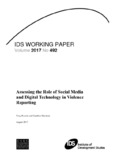| dc.contributor.author | Roberts, Tony | |
| dc.contributor.author | Marchais, Gauthier | |
| dc.date.accessioned | 2017-08-31T11:12:03Z | |
| dc.date.available | 2017-08-31T11:12:03Z | |
| dc.date.issued | 2017-08 | |
| dc.identifier.citation | Roberts, T. and Marchais, G. (2017) Assessing the Role of Social Media and Digital Technology in Violence Reporting, IDS Working Paper 492, Brighton: IDS | en |
| dc.identifier.isbn | 978-1-78118-385-4 | |
| dc.identifier.issn | 2040-0209 | |
| dc.identifier.uri | https://opendocs.ids.ac.uk/opendocs/handle/20.500.12413/13161 | |
| dc.description.abstract | The use of social media and digital technologies has radically changed the way that information about violence is captured, reported, analysed and acted upon. People’s use of social media played a significant role in the Egyptian revolution, post-election violence in Kenya, and drug-cartel violence in Mexico. Social media can be used to provide humanitarian agencies, policymakers and academics seeking to understand and respond to violent crises with data unavailable from other sources. After an initial period of uncritical optimism regarding the potential of social media and digital technologies there is now, however, a growing recognition that they come with new practical, ethical and methodological limitations. Indeed, social media content is often the target of conscious distortions, manipulations, or censorship by a range of actors. Bias of several kinds can significantly distort social media data and reduce their representativeness. This paper assesses the role of social media and digital technologies in the reporting of violent events, and evaluates their relative strengths and weaknesses as compared to other means available. It seeks to understand how social media and digital technology data are collated, how reliable the data are, and what practical and ethical issues are associated with their collection and use. | en |
| dc.description.sponsorship | ESRC | en |
| dc.language.iso | en | en |
| dc.publisher | IDS | en |
| dc.relation.ispartofseries | IDS Working Paper;492 | |
| dc.rights | All rights reserved. Reproduction, copy, transmission, or translation of any part of this publication may be made only under the following conditions:
• with the prior permission of the publisher; or
• with a licence from the Copyright Licensing Agency Ltd., 90 Tottenham Court Road, London W1P 9HE, UK,
or from another national licensing agency; or
• under the terms set out below.
This publication is copyright, but may be reproduced by any method without fee for teaching or nonprofit purposes, but not for resale. Formal permission is required for all such uses, but normally will be granted immediately. For copying in any other circumstances, or for re-use in other publications, or for translation or adaptation, prior written permission must be obtained from the publisher and a fee may be payable.
Permission to reuse Figures 1.1 and 1.2 must be sought directly from the cited publisher. | en |
| dc.rights.uri | http://www.ids.ac.uk/files/dmfile/IDSOpenDocsStandardTermsOfUse.pdf | en |
| dc.subject | Conflict | en |
| dc.subject | Technology | en |
| dc.title | Assessing the Role of Social Media and Digital Technology in Violence Reporting | en |
| dc.type | IDS Working Paper | en |
| dc.rights.holder | IDS | en |
| dc.identifier.team | Digital | en |
| rioxxterms.funder | Default funder | en |
| rioxxterms.identifier.project | Default project | en |
| rioxxterms.version | VoR | en |
| rioxxterms.funder.project | 9ce4e4dc-26e9-4d78-96e9-15e4dcac0642 | en |

